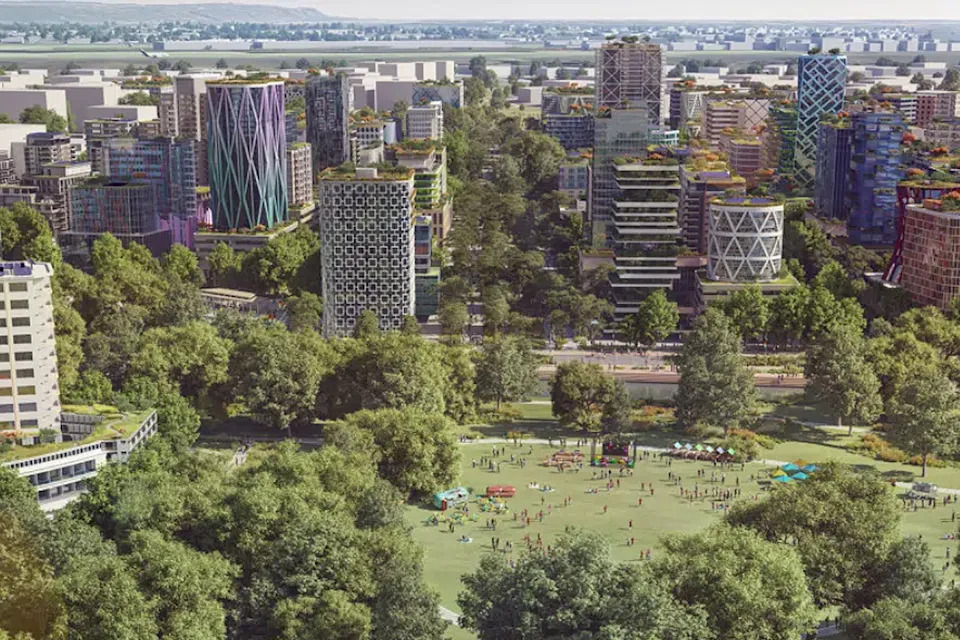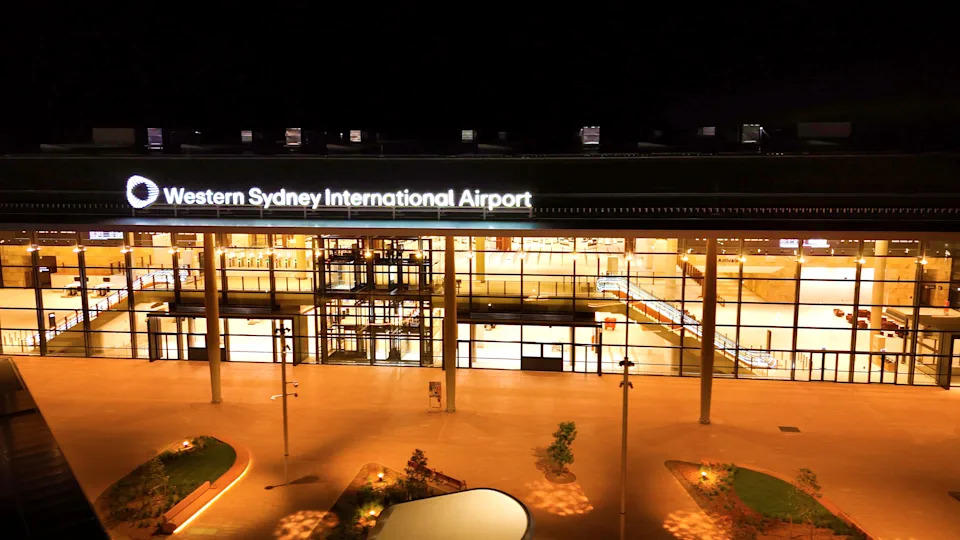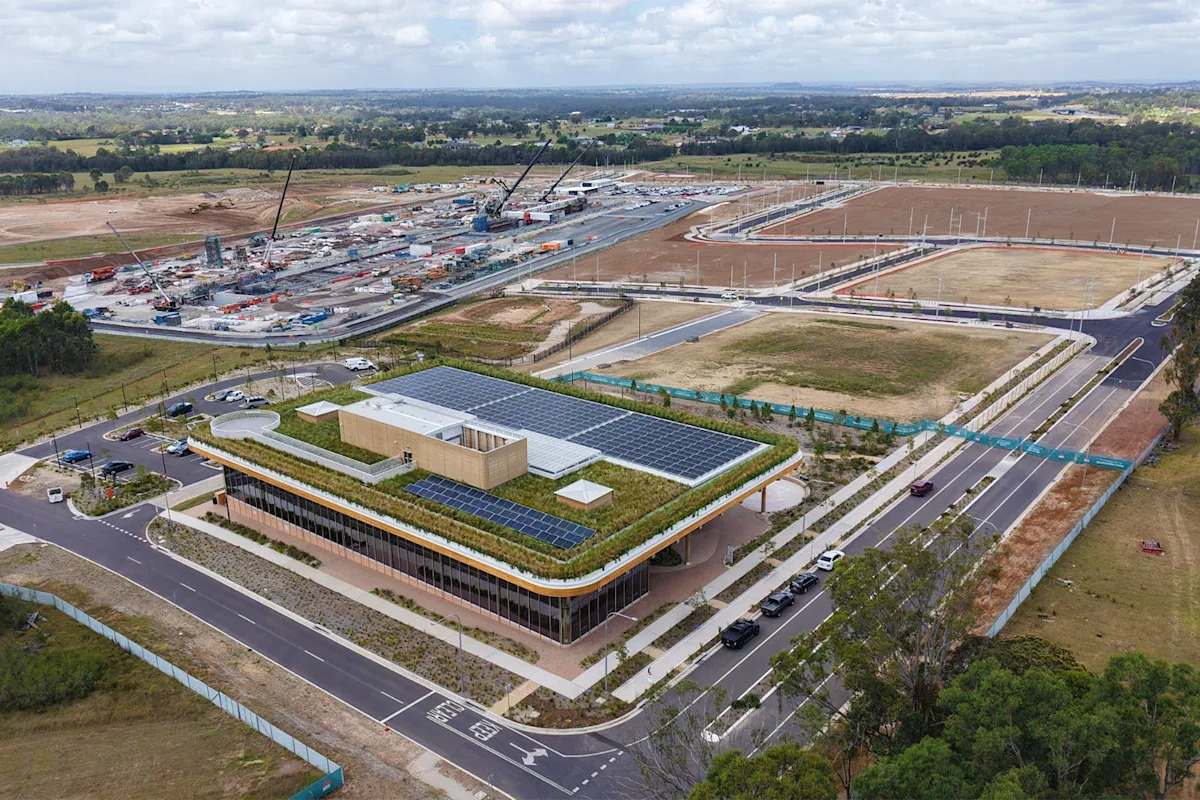Bradfield City is being billed as Australia’s first entirely new city in more than 100 years — an “ultra high-tech” urban hub that promises jobs, innovation and sustainable design in Sydney’s far west.
It’s nestled beside the new Western Sydney International Airport, which on Tuesday welcomed its very first flight just before 9 am, marking a major milestone in the development.
Bradfield sits in one of New South Wales’ hottest corridors, where summer temperatures regularly push past 40 degrees. The $1 billion development is meant to redefine how cities grow — a “green and connected” alternative to the sprawling, car-dependent suburbs that dominate the region.
But while excitement builds around the futuristic project, experts warn its greatest challenge may not be attracting residents or investors — it could be surviving the heat.

An artist’s impression of how the new Bradfield City, in Sydney’s far west, will look. Source: NSW government
Built for the future — but can Bradfield beat the heat?
Some experts say it remains to be seen whether the technology and clever design can truly outsmart the climate.
The Bradfield Development Authority told Yahoo News that the city’s master plan embeds “climate-responsive principles into every layer of planning and delivery,” with more than 36 hectares of open space, a two-hectare Central Park, and a 2.2-kilometre “Green Loop” linking streets and parklands.
An ambitious 40 per cent tree canopy target — double that of most Sydney suburbs — aims to cool the landscape, alongside shaded promenades, water-sensitive design, and a first-of-its-kind digital network of smart poles providing lighting, Wi-Fi and e-bike charging.
The city’s first landmark, known simply as the First Building and pictured above, sets the tone. Its rooftop hosts a self-sustaining “biosolar” ecosystem of 14,000 native plants and 319 solar panels that together cool the roof surface in summer and insulate it in winter. It’s won 12 design awards so far, including the 2025 Good Design Award for sustainability.
But as climate scientist Dr Lucy Richardson from Monash University points out, success will depend on whether these measures are built into the city’s DNA — not just its marketing.
“It’s great to see consideration of these issues being done right from the start. Urban heat is a significant issue for most Australian cities, and Western Sydney is one of the worst affected,” she told Yahoo News Australia.
“Projections of the likely impact of climate change suggest that this will only get worse until emissions are curbed, and even for some time after that due to inertia in the climate system.”
Richardson emphasised that embedding climate-responsive measures into the city’s initial planning—as they can be built into the layout of streets, drainage, water supply, zoning and building standards — gives Bradfield the best chance to effectively manage heat. Retrofitting these solutions later is much harder, she said, and unlikely to achieve the same levels of effectiveness or efficiency.
When high tech isn’t enough
Urban planner Professor Joe Hurley from RMIT agrees that glossy technology alone won’t make Bradfield livable. He pointed out that heatwaves cause more deaths in Australian cities than fires or floods.
At neighbouring Badgery’s Creek last week there were two days above 37 degrees, and on January 4, 2020 the temperature there reached a record 47.6 degrees.
“In new developments like Bradfield, it’s essential we create urban landscapes that are heat-resilient,” he said. “Western Sydney experiences some of the most significant urban heat conditions of Australian cities due to climate, extensive built form, and relatively low vegetation cover.”
Hurley said features like green roofs, tree canopy targets, shaded streets, and reflective materials can all play a role in reducing heat impacts. “But what is critical here is that it is the cumulative impacts that matter — a few green roofs might look good in marketing material but will have little impact at the neighbourhood scale,” he said.
Ultra high-tech does not equate to a liveable, inclusive, resilient environment.
Professor Joe Hurley
“Technology may support these objectives, but it is often a distraction to more substantive efforts in good design and infrastructure provision.”
Transport, trees and timing are key
Sydney-based strategic transport policy and planning leader Matt Faber believes linking sustainable design, density, and transport is what could make or break Bradfield. Faber said the city’s plans look good on paper, particularly the inclusion of a rail link, but success will depend on the timing and sequencing of infrastructure. “It’s not just about building the railway. You need schools, parks, local shops, childcare, and other social infrastructure first,” he said.
“Everybody knows that trees mitigate heat,” he said. “You can’t do that early enough.”
Faber said “breaking up great areas of concrete” will be key. “Not building six lanes of road all at once,” he said. “Maybe building four, giving lanes to a bus operation, then using the extra width that you might have saved to plant lots of trees, so that by the time people move in, those trees are being established and you’re getting some kind of cooling effect from them.”
Faber said at this stage, whether Bradfield “eventuates in reality as a sustainable urban development is very much open to question”. He also warned that developers alone can’t deliver the type of community Bradfield aspires to be.
“There is a need for leadership at all three levels of government,” he said. “The state government has obviously got to be in the lead position, but the local councils as well have to be much more involved.”
Despite the challenges, Faber sees high potential for Bradfield. “With careful planning… there’s no reason it can’t be a thriving city,” he said. The question, Faber added, is whether the early stages will be managed well enough to avoid the pitfalls we see in other new suburbs.

The new Western Sydney Airport is due to open in late 2026. Source: Getty
Creating a city takes more than buildings
That risk — of a hollow, infrastructure-first “dormitory suburb” — is one Professor Nicky Morrison from Western Sydney University is also watching closely. She said there is a big opportunity to plan a city properly from the outset, integrating land use, transport, industry, and environment rather than retrofitting later.
The main challenge, she explained, is creating a real community, not just infrastructure. It takes time to build identity, services, and local life, and there is a risk that early residents could feel isolated if schools, shops, and green space lag behind housing delivery.
Getting the sequencing right will be critical, she added, and Western Sydney’s heat and climate challenges make tree canopy and shading essential early priorities.
“Affordable housing, social services, and green space must be core elements, not afterthoughts,” she said. “Western Sydney’s heat and climate challenges make tree canopy and shading essential early priorities.”
She explained that Bradfield could be a model for how Australia builds cities in a changing climate, but it needs more than buildings — it needs people who feel they belong there. Without that human layer, even the most sustainable city risks feeling sterile.
Bradfield’s promise of 10,000 homes and 20,000 jobs is ambitious. The Authority says most new roles will stem from “high-value industries of the future,” including advanced manufacturing, aerospace, cleantech, defence and higher education — a bid to rebalance Western Sydney’s economy away from traditional trades and logistics.
Morrison warns that success depends on “sustained investment and strong market demand”.
Despite the challenges, most experts agree that Bradfield’s intent is strong — a rare chance to build a modern Australian city from the ground up. “There’s a lot of understanding of the risks. It’s just whether the investment and sequencing are right to actually mitigate them,” Faber said.
Do you have a story tip? Email: newsroomau@yahoonews.com.
You can also follow us on Facebook, Instagram, TikTok, Twitter and YouTube.


